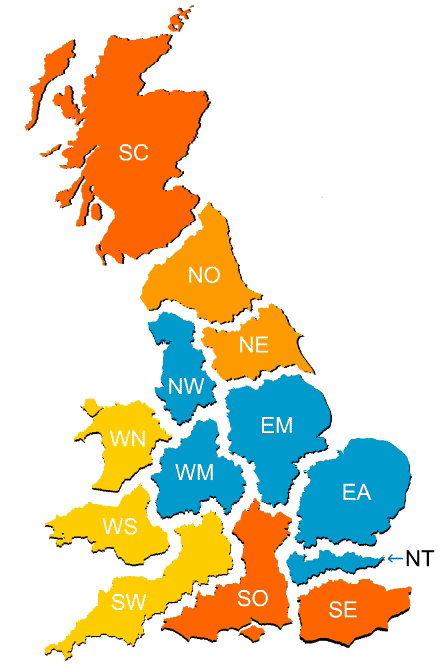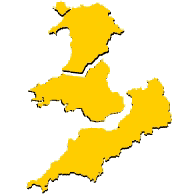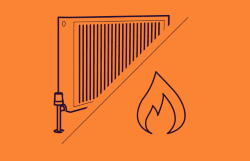The LDZ Map, who is your gas distributor, and how does this affect the cost?
Gas, whether from the North Sea, pipelines from Europe or delivered as LNG (liquified natural gas), travels through the high-pressure transmission system owned by National Grid and then through the medium and low-pressure distribution networks to reach the consumer.
The gas distribution networks (GDNs) are the penultimate stage in the delivery process. There are eight distribution networks throughout the British Isles, which are owned by Cadent, Northern Gas Networks, SGN (formerly Scotia Gas Networks) and Wales & West Utilities. These are shown on the map below, together with the ENA member independent gas transporters (IGTs), which operate nationally. If you want to upgrade, downgrade, or get a new gas supply, your local distribution network will deal with this. If you need help with a new site/supply please get in touch, we can help you find the information you need and save time and money.
Knowing your LDZ (Local Distribution Zone) or Distributor area will also help you find the right price; different areas have different standing charges, transmission and metering costs. What’s your LDZ Area? To search our database, please enter your postcode.

Network Map |
Network Company NameSGNNetwork Short CodeSCT – ScotlandLDZ(s)SC – Scotland |
Network Map |
Network Company NameNorthern Gas Networks LtdNetwork Short CodeNOE – North of EnglandLDZ(s)NO – Northern NE – North East |
Network Map |
Network Company NameCadentNetwork Short CodeNWT – North West LDN – London WMD – West of Midlands EOE – East of EnglandLDZ(s)NWT – North West WMD – West Midlands EM – East Midlands EA – East Anglia NT – North Thames |
Network Map |
Network Company NameSGNNetwork Short CodeSOE – South of EnglandLDZ(s)SO – Southern SE – South East |
Network Map |
Network Company NameWales & West UtilitiesNetwork Short CodeWTW – Wales & The WestLDZ(s)WN- Wales North WS – Wales South SW – South West |
Who operates the gas distribution network?
The gas distribution network in the UK is operated by several network operators, each responsible for specific regions. These operators play a crucial role in ensuring the safe and efficient delivery of natural gas to homes and businesses across the country. Some of the major network operators include British Gas, SGN, and Cadent, among others. Natural gas is transported through a vast network of pipelines and transmission systems, overseen by these operators. The national grid and regional gas distribution networks form the backbone of this infrastructure, allowing gas to be supplied to various areas. Independent Gas Transporters (IGTs) also play a significant role in the distribution process. They own and operate smaller networks, connecting homes and businesses to the main gas supply. This diversification contributes to a more resilient and efficient gas supply chain. Regulation and oversight of the gas industry, including the distribution network, fall under the authority of Ofgem, the national regulatory body. Ofgem ensures that network operators adhere to specific standards and guidelines to guarantee safety, reliability, and fair practices within the industry.
How do I know if my gas supply is working?
To check if your gas supply is working, there are a few steps you can take. First, ensure that your gas appliances, such as stoves and heaters, are turned on and functioning correctly. If they are not working, it may indicate an issue with your gas supply. Next, check the gas meter. The gas meter is usually located outside your property and is connected to the gas distribution network. Ensure that the meter display is active and showing readings. If the display is blank or not changing, there might be a problem with the gas supply. You can also contact your gas supplier, whether it’s British Gas, SGN, Cadent, or another company, to inquire about any known issues in your area or to report a gas outage. They can provide information on gas supply status and any ongoing maintenance work. In case of a gas emergency or suspected gas leak, it’s crucial to act quickly. Turn off the gas supply at the mains if it is safe to do so and open windows and doors to ventilate the area. Leave the property and contact the National Gas Emergency Helpline immediately. Understanding the regions and the network operators involved in the gas distribution network can also be helpful in identifying potential supply disruptions. Staying informed about energy industry updates and being aware of local gas supply news can provide valuable insights into the overall gas supply situation.
What Role Does the Gas Distribution Network Play?
The gas distribution network plays a crucial role in ensuring the efficient and reliable supply of natural gas across the UK. It is an extensive system of pipelines and infrastructure that connects the gas supply from the National Grid and other sources to homes, businesses, and industries in different regions. The network operators, such as British Gas, SGN, Cadent, and others, are responsible for managing and maintaining this vast gas distribution network. They operate the transmission system, which transports natural gas at high pressure from production facilities, such as those in the North Sea, to various regions across the country. Within the gas distribution network, there are gas mains, a network of pipes that carry the pressurized gas from the transmission system to local distribution points. From there, the gas is further distributed to individual properties through smaller distribution networks owned and operated by different companies. The gas distribution network ensures that gas is readily available to meet the energy needs of households, businesses, and industries. It plays a significant role in supporting the UK’s energy industry, enabling the use of gas-fired power plants and gas boilers for heating and electricity generation. Moreover, the network operators work to enhance the efficiency and safety of gas supply by investing in infrastructure upgrades, adopting new technologies, and implementing environmentally friendly practices. This continuous improvement contributes to a greener and more sustainable gas industry.
How Does the National Gas Transmission System Differ to the GDNs?
The National Gas Transmission System and the Gas Distribution Networks (GDNs) serve distinct roles in the UK gas industry, ensuring the efficient supply of natural gas to consumers and businesses. The National Gas Transmission System, operated by the National Grid, plays a pivotal role in transporting natural gas from production facilities, such as those in the North Sea, to various regions across the UK. It is a high-pressure transmission network that covers long distances and is responsible for transporting large volumes of gas. The system operates at higher pressures to enable gas to travel over vast distances through large pipelines, maintaining the flow and pressure needed for long-distance transmission. On the other hand, the Gas Distribution Networks, operated by companies like British Gas, SGN, and Cadent, are responsible for distributing natural gas locally within specific regions. They receive gas from the National Gas Transmission System and deliver it to homes, businesses, and industries through a network of smaller distribution pipelines. These networks operate at lower pressures suitable for local distribution, ensuring gas is delivered safely and reliably to individual properties. While the National Gas Transmission System focuses on long-distance, high-pressure transmission, the GDNs concentrate on local, low-pressure distribution. The transmission system connects regions and major gas-consuming areas, while the distribution networks serve local communities.
Who Regulates the GDNs?
The Gas Distribution Networks (GDNs) in the UK are regulated by the Office of Gas and Electricity Markets (Ofgem), an independent regulatory authority responsible for overseeing the gas and electricity industries. Ofgem plays a crucial role in ensuring that the GDNs operate in a fair, safe, and efficient manner while maintaining a reliable supply of natural gas to consumers. The GDNs, including companies like British Gas, SGN, and Cadent, are responsible for distributing natural gas locally within specific regions across the UK. Ofgem regulates these network operators to promote competition, protect consumers’ interests, and encourage innovation in the gas industry. Under Ofgem’s oversight, the GDNs must adhere to various regulations and standards to maintain the safety and integrity of their gas distribution networks. This includes ensuring the proper maintenance of gas mains, pipelines, and other infrastructure, as well as addressing any gas emergencies promptly and efficiently. Furthermore, Ofgem regulates the pricing and tariffs set by the GDNs to ensure that consumers receive a fair deal. They monitor the companies’ performance and review their investment plans to promote efficiency and cost-effectiveness.
What’s an independent gas transporter (IGT)?
An Independent Gas Transporter (IGT) is a company that operates within the UK gas industry but independently of the main Gas Distribution Networks (GDNs) like British Gas, SGN, and Cadent. While the GDNs are responsible for distributing natural gas to homes and businesses across specific regions in the UK, the role of the IGTs is focused on the transportation of gas through their own separate gas networks. IGTs own and operate their gas transmission systems, including pipelines and gas mains, which connect to the national gas transmission network managed by the National Grid. These independent companies cater to areas not covered by the GDNs, such as new housing developments or specific industrial sites. IGTs play a vital role in ensuring that gas supply reaches consumers in regions where the GDNs do not operate. They are regulated by Ofgem to maintain safety standards, uphold the integrity of their gas networks, and adhere to the policies and regulations governing the gas industry.
Gas distribution network operators
Gas Distribution Network Operators (DNOs) are essential entities within the UK gas industry responsible for managing and maintaining the gas distribution network that supplies natural gas to homes, businesses, and industries across the country. Some well-known DNOs include British Gas, SGN, and Cadent, which play a pivotal role in ensuring a reliable and safe gas supply to consumers. These operators oversee the vast network of gas pipelines, mains, and transmission systems that transport natural gas from the National Grid to various regions throughout the UK. The DNOs use their expertise to regulate gas pressure and flow, ensuring a steady and efficient distribution of gas to end-users. One crucial aspect of the DNOs’ role is to understand the regions they serve, as each area may have different demand patterns and infrastructural requirements. They work closely with energy networks associations, industry regulators like Ofgem, and other stakeholders to ensure compliance with industry regulations and safety standards. The gas distribution network operators are committed to promoting greener practices and may adopt renewable energy sources like bio-methane or low-carbon alternatives in their networks. They continuously invest in modernizing the gas infrastructure, implementing advanced technology and smart solutions to enhance efficiency and minimize environmental impact.
Background of the UK GDNs
The UK Gas Distribution Networks (GDNs) have a rich background intertwined with the development of the gas industry in the country. The gas network in the UK comprises an extensive and intricate gas distribution network operated by various network operators, including British Gas, SGN, and Cadent. The history of the UK GDNs can be traced back to the discovery of natural gas in the North Sea, which led to a significant shift from coal to gas as the primary energy source. As demand for gas increased, the need for a reliable and efficient distribution system became apparent. The National Grid, a key player in the gas industry, plays a vital role in the transmission of natural gas from the North Sea to the distribution networks. The gas is transported through pipelines at high pressure, ensuring it reaches all corners of the UK. The gas distribution network operators (DNOs) are responsible for managing the regional gas distribution networks across the UK, understanding the unique requirements and demands of different regions. They own and operate gas mains, transmission systems, and pipelines that deliver gas to homes, businesses, and industries. Over the years, the UK GDNs have faced challenges, including the need to incorporate renewable energy sources and transition to a low-carbon future. Additionally, they have been subject to regulatory oversight by Ofgem, ensuring fair tariffs, efficient operation, and value for money for consumers.
What are the components of a gas network?
The gas network in the UK, also known as the gas distribution network, is a vast and complex infrastructure that plays a crucial role in supplying natural gas to homes, businesses, and industries across the country. It is operated by various network operators, including British Gas, SGN, and Cadent. The components of the gas network include gas mains, transmission systems, and pipelines that span across the UK, delivering natural gas from the North Sea and other sources to the consumers. The gas is transported at high pressure through transmission networks managed by the National Grid, ensuring efficient distribution to different regions. Within the gas distribution network, there are regional gas distribution networks operated by companies like Northern Gas Networks and Scotia Gas Networks. These networks are responsible for understanding the specific requirements and demands of different regions and delivering gas to homes and businesses. Independent Gas Transporters (IGTs) also play a role in the gas network. They are responsible for distributing gas in certain areas independently of the traditional network operators. To ensure safety and compliance with regulations, the gas network components undergo regular inspections and maintenance. Ofgem, the regulatory body, oversees the gas industry and sets tariffs to ensure consumers get value for money.




